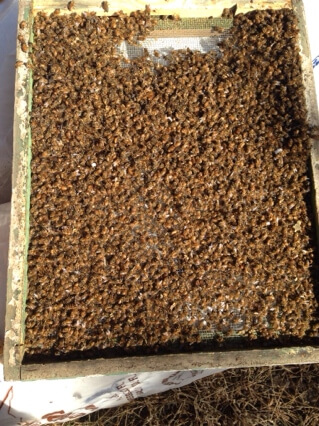
Yesterday we finally had a break in the weather. After enduring record breaking cold last week, we had a rare high of 58 degrees. As most beekeepers in my area, I immediately broke into the hives. Remember, hives should not be opened until the temps reach 50 degrees so my window of opportunity was for a few hours from noon till four.
I knew feed was probably running low in my candy board/pollen patty feeders so I prepared my inventory of replacement feed, donned my gear and headed to the bee yard.
For some time, I have been concerned about my Failure to Thrive hive which sits in the most wind-sheltered section but also the shadiest. My dear husband took advantage of the opportunity and spent the morning cutting the cedar tree which blocks most of the morning sun. With that task complete, I decided to inspect this hive first, expecting the worst.
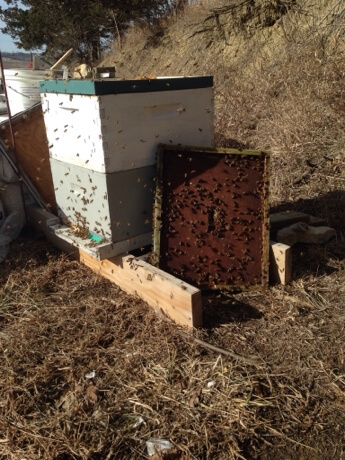
Much to my surprise and pleasure, the hive was full, bustling and appeared to be in good shape with honey stores. From the beginning, this has been a particularly aggressive hive. One in which I have recieved the most stings. They agitate quickly and I like to get in and get out! So, as you can imagine, I was happy to refill the feeder and close up the hive.
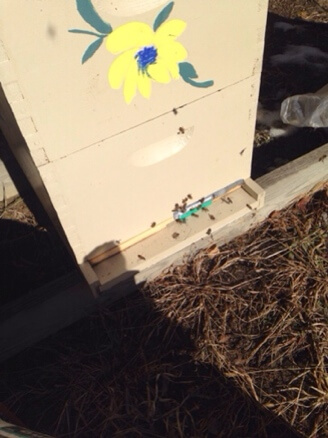
Moving on to my original hive, I was happy to find again, thriving, active. Down somewhat on stored honey but not surprising with the number of bees in this very healthy hive. Temperament wise- this hive is very even-keeled. I find myself practically face down in the boxes of this hive(appropriately dressed of course) and the hive remains easy to work around.
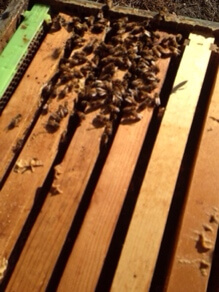
Feeling pretty happy, I moved on to my favorite blonde hive. I suppose it seems a bit silly but I feel very bonded with these pretty bees. Remember, they were the hive I fought the ongoing battle with the yellow jackets in the fall. So, when I opened the lid and found this very small cluster of bees in the top box, I felt sick. More than one half of the hive dead. Thousands of dead bees at the bottom and little to no honey frames left. And its only mid January in Kansas. I cleaned out the dead bees and robbed a couple of frames from my healthiest hive. I could not find the Queen but assume she might be somewhere in the middle of the cluster on the above frames. I was trying not to damage too many of the survivors. As bees like to move up, I tried to get the most honey in the top box and contemplated pulling one box off entirely. I did not as I was afraid of losing the bees that were left but if another opportunity weather wise arrises, I probably will. Refilling the pollen patties and candy boards my stave off the inevitable but, Spring is a long time away. 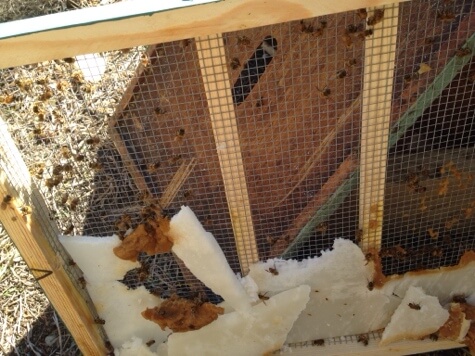
Remember bees can survive cold temps if moisture is kept at bay but lack of food stores leads to starvation. Keep your fingers crossed for this little group of bees huddled together. If we can make it to spring, I will rob off a couple of frames of brood from the other hives to strengthen their numbers.
As a beekeeper, I spent the afternoon trying to figure out what I could have done to prevent this. I discussed it with another beekeeping friend who also suffered a hive loss. I know I will be more aggressive next fall in my yellow jacket prevention program. A hive that spends its time fending off marauders cannot make and store honey. I know my fall feeding program was adequate. Repositioning this hive might be another option as it has one side with the most northern exposure(despite my Kansas windbreaks) Being a responsible beekeeping is about evaluating your methods and learning from your losses.






 I will pray for your bees, and for Spring to come early!!
I will pray for your bees, and for Spring to come early!!